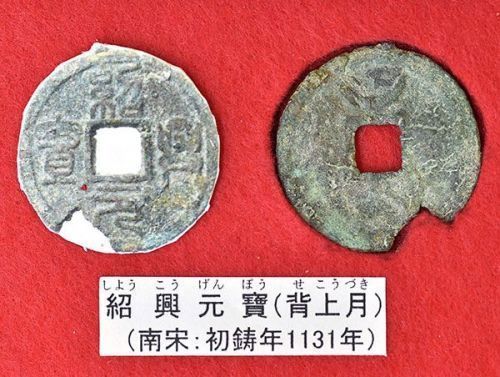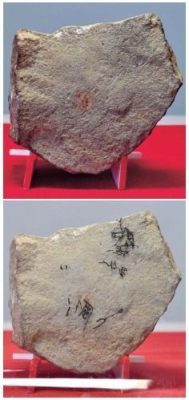Nansong coins, carved stone tools uncovered at Shuri Castle Ruins deemed valuable artifacts

Nansong era coins from China excavated from the Kyonouchi remains at Shuri Castle, February 3, Okinawa Maizo Culture Center (Left is the front side, Right is the back side)
February 4, 2017 Ryukyu Shimpo
Two discoveries excavated from the Kyonouchi remains at Shuri Castle in 1996 had their origin determined this week. At the time of excavation, details regarding these artifacts were unclear, but it has been determined that the first discovery was Shokogenpo, the official currency from 12-13th century Chinese Nansong dynasty. The second was carved stoneware made sometime from the 15-17th century, which have images that were carved into the stone with small knives. The announcement was made on February 3 by the Okinawa Maizo Culture Center. The coins are the first of their kind to be excavated in Okinawa, and are specifically of the “Sekouzuki” variety, signified by the crescent moon pattern carved into the back side of the coin. The discovery of Sekouzuki coins are rare, and the culture center believes this to be the first instance anywhere in Japan.

(Top) Carved stoneware unearthed at the Kyonouchi remains at Shuri Castle. (Bottom) After covering with a clear film, carved images of boats and tiny people can be seen. February 3, Maizo Culture Center
Shoujin Heshiki, head of the Okinawa Board of Education, commented, “These two discoveries are a rare and valuable thing.”
Shokogenpo coins were first minted in 1131 CE, and are generally an alloy forged with copper, and have a diameter of 3 cm.
The front surface of the roughly 15 cm square carved stoneware was used as whetstones to sharpen blades, and have the images of a sea voyage, with things such as sail boats and waves, carved into it. This is viewed to be a prayer for safe sea voyages.
Previously, stone slabs with sea-themed images carved into them have been excavated at Chatan and Kadena, but this is the first finding of a stone utensil with these depictions. The Maizo Culture Center is saying that it was likely carved by a mason or someone similar, but that the intent is still unclear.
Kyonouchi was a place used for prayer and rituals during the Ryukyu Dynastic era, and men were prohibited from entering. It is possible that the stoneware uncovered here were used
for a ritual, but the details remain unclear.
The artifacts will be on display in the,”Shuri Castle Kyonouchi Artifact Exhibit” at the Maizo Culture Center from February 21 through May 14. Entrance to the exhibit is free.
(Translated by T&CT and Sam Grieb)
Previous Article:With success of Okinawan hero Ryujin Mabuyer, more Asian heroes to come
Next Article:About 250 protest at Camp Schwab gates as bad weather delays work on Henoko base
[Similar Articles]
- Ancient Roman and Ottoman copper coins unearthed for the first time in Japan at Katsuren Castle, possibly from maritime trade
- 40th anniversary coin of Okinawa’s reversion will be issued with a full-color Shuri Castle design
- Mysterious symbols found engraved in stones in newly discovered castle wall at Nakagusuku Castle Ruins
- Madama-michi Road from 16th century excavated around Shurei gate
- University of Tokyo faculty gathering photographs to create a 3D digital recreation of Shuri Castle to serve as “tourist attraction until the castle is rebuilt”
 Webcam(Kokusai Street)
Webcam(Kokusai Street)


